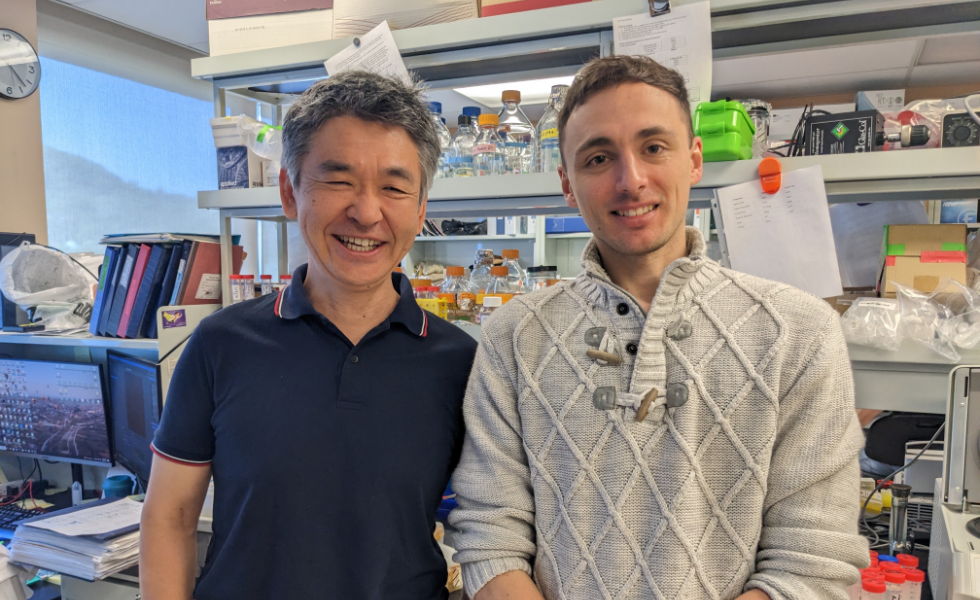
From left to right: Hideto Takahashi and Benjamin Feller.
Brand new work from Dr. Hideto Takahashi, Director of the Synapse Development and Plasticity Research Unit at the Montreal Clinical Research Institute (IRCM) and his team, recently uncovered a new mechanism that might play an important role in the development of pathologies called synucleinopathies, which include the Parkinson’s disease, dementia with Lewy body and so on. This work, published in the journal Cells, could contribute to pave the way toward new therapeutic options for Parkinson and other associated diseases.
The Parkinson’s disease is an uncurable degenerative condition that affects around 10 million people around the world. It is associated with motor symptoms such as tremor, freezing and rigidity as well as cognitive dysfunctions which culminate in time to dementia. Like Alzheimer’s disease, which affects 55 million people worldwide, the Parkinson’s disease evolution can only be slowed down with current available therapies.
Synucleinopathies share a common mechanism: a pathological aggregation of the alpha-synuclein molecule, that is toxic once it gets inside the neuron, and that acquires the ability to propagate between neurons. This molecule is naturally abundant within the neurons in the brain. However, when it abnormally aggregates, it causes multiple dysfunctions that impair the normal function of neurons, and it leads to a progressive neurodegeneration through its spreading capability.
A Pathological Process That Raises Questions
For years, the scientific community has investigated many aspects of the phenomenon, hoping to answer the basing questions: What triggers alpha-synuclein aggregation, how does it induce multiple dysfunctions, and how does it spread throughout the brain?
In Takahashi’s lab, PhD Student Benjamin Feller has been focusing on the how. How does alpha-synuclein make its way into the neuron? The team discovered that a protein that is naturally found on the surface of the neurons might be to blame, or at least a specific section of it. Called Neurexin, the protein acts like a receptor. And by allowing the alpha-synuclein molecule to bind to the neurons, it might be the door by which alpha-synuclein will access the inside of the neurons, thus contributing to the disease’s development. Alpha-synuclein is then transmitted from a neuron to the other. Eventually, with less and less functional neurons available in time, the disease progresses in its most debilitating forms.
The team was even able to identify which part of the Neurexin is responsible for binding the alpha-synuclein molecules. They also showed in an in vitro model that by genetically deleting the section of Neurexin involved in binding the molecule, they are able to prevent the binding of alpha-synuclein to the neuron surface.
A Discovery With a Broad Potential
This highly promising new light on the underlying mechanism by which Neurexin might help alpha-synuclein access the inner side of the neuron is not good news only for families with Parkinson’s disease. Recent work from Takahashi’s lab, shows that Neurexin plays an important role in the development and the progression Alzheimer’s disease as well.
“It is very encouraging because, we now know that if we find a solution to close the Neurexin’s “door” or make it unavailable to alpha-synuclein, we may find a way to address both Parkinson’s and Alzheimer’s disease,” explained Dr. Takahashi.
The next step for Takahashi’s lab is to push forward and investigate this finding in a preclinical model that is already being developed by the team.
“Although we are still very far from a human application, this finding is definitely paving the way toward new highly promising investigations that could ultimately lead to interesting therapeutic options,” concluded PhD candidate Benjamin Feller.
Acknowledgement
This work was made possible through the valuable supports of Parkinson Canada, the Canadian Institutes of Health Research (CIHR), Fonds de la recherche du Québec–Santé (FRQS), Healthy Brains Healthy Lives initiative at McGill University and Natural Sciences and Engineering Research Council of Canada (NSERC).



